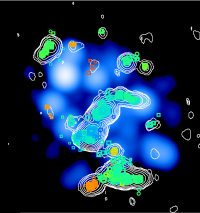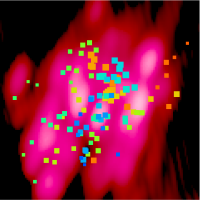Red Supergiant Cauldrons Let Off Steam
17th April 2007
Steamy clouds have been observed bubbling away from four massive stars known as red supergiants. A team from Jodrell Bank, using the MERLIN array and European and Global VLBI Networks, found that the stars are actually 'steaming' as they enter their final death throes, driving out thick clouds of water vapour immersed in more tenuous gas.
Dr Anita Richards, who is presenting results at the RAS National Astronomy Meeting in Preston on 17th April, said, "Red supergiants lose more than half their mass before ending their lives as supernovae. Our observations show that this doesn't happen smoothly, like an onion shedding layers. We see water vapour clouds which are over-dense, over-magnetised and rapidly accelerated away from the star. They are embedded in a cooler, more diffuse gas producing distinctive emission from hydroxyl, a break-down product of water."
The group studied 'maser' emissions from the gas clouds surrounding the star: molecules in the gas amplify and emit beams of microwave radiation in much the same way as a laser produces very narrow, bright beams of light. Water emits at 1.3 cm wavelength, under hot, dense conditions (around 1000 degrees Kelvin). Hydroxyl emission at 18.0 cm can only occur from cooler, less dense gas and it was very unexpected to detect it as close to two of the stars as the water masers. The only explanation seems to be that the water masers come from clumps where the gas density is, typically, 50 times higher than the rest of the wind from the star. Supporting evidence comes from measurements of the magnetic field strength associated with the hydroxyl masers, which is much weaker than that of the adjacent water masers, as is expected if the hydroxyl environment is more diffuse.
 |  |
These images show the water vapour clouds in shades of blue (S Persei) and red (VX Sagitarii), observed using MERLIN at 1.3 cm wavelength. The image of S Persei is about 370 AU across and the image of VX Sagitarii is about 680 AU across, where an AU is the distance between the Earth and the Sun. The Doppler shifts of the maser spectral lines mean that we can measure the speed and direction of the wind blown away from the star. The symbols show the positions of the hydroxyl masers observed using MERLIN and VLBI at 18.0 cm wavelength (the 'mainline' transition), colour coded according to velocity with respect to the star (blue is expanding towards us, red away from us etc.). The high resolution of Very Long Baseline Interferometry, using radio telescopes in Europe and the USA, confirmed that the hydroxyl masers are found in the water maser region and the appearance is not just a projection effect. Click images for high resolution versions.
The water vapour clouds appear to be very dusty and are accelerating faster than the surrounding gas. Only a few of these steam clouds form each stellar period (several years), filling just a few percent of the volume of the maser shell around the star, but they contain most of the mass lost by the star.
In the study, the maser emissions from the water vapour appeared to show that the clouds had a lifetime of only a few decades, although clouds were observed at distances that would have taken about a century to reach. The puzzle was solved by comparing the MERLIN results with longer-term observations from the Puschino radio telescope in Russia, which revealed individual clouds winking off and back on again due to the fickle nature of maser excitation or beaming. Dr Anita Richards said, "These observations are intriguing because, from the size of the masing shell, we estimate that the water vapour clouds take about 100 years to bubble away into interstellar space, but we can only actually 'see' any particular cloud for a few years."
The group hope to follow this up by using the e-MERLIN, eVLBI and ALMA networks of radio telescopes to trace the mass loss process back to the star to discover whether star-spots, convection cells, dust formation or some other mechanism gives birth to the clumps.
FURTHER INFORMATION
The team
The research was conducted by Anita Richards, Jim Cohen, Phil Diamond, Sandra Etoka , Malcolm Gray and Wouter Vlemmings from Manchester University; Mike Masheder from Bristol University; Indra Bains from the University of Melbourne; Ania Bartkiewicz and Marian Szymczak from the Niclaus Copernicus University, Torun; Evgueny Lekht and Eduardo Mendoza-Torrez from INAOEP, Mexico; Koji Murakawa from the Max Planck Institute, Bonn; Huib van Langevelde from JIVE/Leiden University, The Netherlands and Jeremy Yates from University College London.
Red Supergiant stars
We studied four Red Supergiants within 7000 light years of the Sun, S Persei, VX Sagitarii, VY Canis Majoris and NML Cygni. Stars more than about 8 times the mass of the Sun live fast and go out in a blaze of glory as a supernova. Even before then, these stars contribute up to half of all the dust and a large proportion of light elements which enrich the interstellar medium (clouds of gas and dust between the stars which will go into the next generation of star formation). Earth-like planets cannot form without dust grains and elements like oxygen, nitrogen, carbon and silicon. Less than one in 200 stars are high-mass at birth, but they make up for that by their productivity. They lose most of their mass in the Red Super Giant stage - when they have swelled up to the size of the orbit of Jupiter or even Saturn and their cool atmosphere allows dust and molecules to form. Betelgeuse in Orion is approaching this stage.
MERLIN
MERLIN (http://www.merlin.ac.uk/), operated by Jodrell Bank Observatory, is the Multi-Element Radio Linked Interferometer Network, an array of radio telescopes distributed around Great Britain, with separations of up to 217km. It operates at wavelengths ranging from 1.3 to 23 cm. At 1.3 cm, the resolution of MERLIN is better than 10 milliarcseconds, even greater than that of the Hubble Space Telescope. MERLIN is operated by the University of Manchester as a National Facility of the Science and Technology Facilities Council. It is currently being upgraded (including connecting the telescopes by optical fibres), which will increase its sensitivity more than tenfold (the e-MERLIN project, http://www.jb.man.ac.uk/news/e-merlin/)
European Very Long Baseline Interferometry Network/Global VLBI
The European VLBI Network (EVN, http://www.evlbi.org/) is an interferometric array of radio telescopes spread throughout Europe and beyond, which conducts unique, high resolution, radio astronomical observations of cosmic radio sources. It is the most sensitive VLBI array in the world, thanks to the collection of extremely large telescopes that contribute to the network. We used it in combination with telescopes from the USA VLBA (http://www.vlba.nrao.edu/).
Pushchino Radio Astronomy Observatory
The Puschino RT-22 LPI radio telescope (http://www.prao.psn.ru/English/index.php) is run by the Lebedev Physical Institute and the Russian Academy of Sciences. It has been used to monitor water vapour masers since 1979.
CONTACTS
Dr Anita Richards
AstroGrid Astronomer
MERLIN/VLBI National Facility
University of Manchester
Jodrell Bank Observatory
Macclesfield
Cheshire SK11 9DL, U.K.
Tel +44 (0)1477 572683 (direct)
Tel +44 (0)1477 571321 (switchboard)
E-mail: a.m.s.richards@manchester.ac.uk
From 16-19th April, Dr Richards can be contacted through the NAM press office (01772 892613)


